It has been quite a while since I’ve written about geometrical dissections. For a brief refresher, you might want to look at my first post on dissections.
But recently my interest has been rekindled — to the point that I started writing a paper a few weeks ago! I often like to share mathematics I’m working on as it’s happening to give you some idea of the process of doing mathematics. The paper has quite a bit more mathematics in it than I’ll include in this post, but I’ll try to give you the gist of what’s involved.
Recall (again, see my first post for a more thorough discussion) that I’m interested in finding dissections that you can draw on graph paper — I find these more enjoyable as well as being accessible to a wider audience. So all the dissections I’ll talk about will be based on a grid.
The first example is a dissection of two octagons to one, such as shown below.
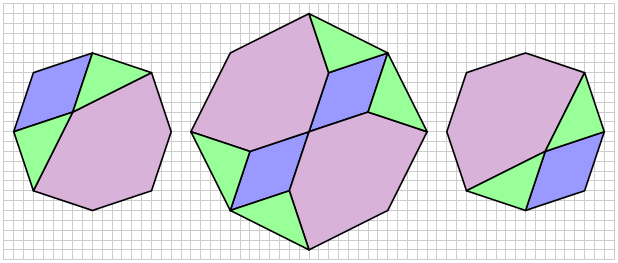
In other words, you can take the pieces from the two smaller octagons, move them around, and build the larger octagon. If you look carefully, you’ll notice that the larger octagon is rotated 45° relative to the smaller octagons. Geometrically, this is because to get an octagon twice the area of a given octagon, you scale the side lengths by Imagine a square — a square with side length
has area
while a square with side length
has area
— which is double the area.
Now think of a segment of unit length. To get a segment of length you need to take a diagonal of a unit square, which rotates the segment by 45° as well as scales it by a factor of
This is why the larger octagon is rotated with respect to the smaller ones.
But what makes this dissection interesting is that there is an infinite family of very similar dissections. By slightly varying the parameters, you get a dissection which looks like this:
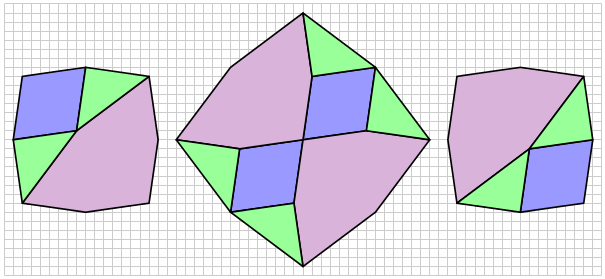
Here, you can clearly see the 45° rotation of the larger octagon. I always enjoy finding infinite families of dissections — it is very satisfying to discover that once you’ve found one dissection, you get infinitely many more for free!
The proof that this always works (which I will omit here!) involves using a geometrical argument — using arbitrary parameters — to show that the green triangles always have to be right isosceles triangles. This is the essential feature of the dissection which makes it “work” all the time.
The second example I’m including in the paper is a dissection on a triangular grid, like the one below.
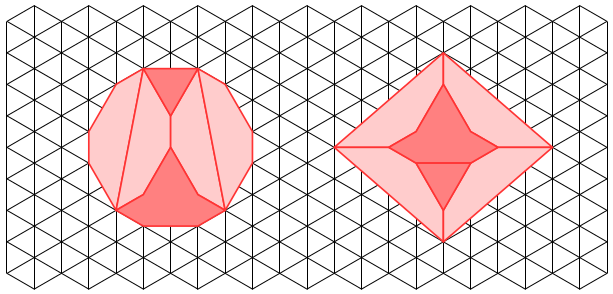
Note that the figure on the left is an irregular dodecagon; that is, it has twelve sides. Recall that the interior angles of a regular dodecagon have measure 150° — but so do the angles of this irregular dodecagon as it is drawn on a triangular grid.
If you look carefully, you’ll see how the sides in the pieces of the dissection on the right match up with sides of the same length from the other pieces. Also, looking at the dissection on the right, you’ll see that around all the interior vertices, there are two angles with measure 150° and one with measure 60°, adding up to 360° — as we would expect if the pieces fit exactly together.
And — as you might have guessed from the first example — this is also one of an infinite family of dissections. As long as the sides of the irregular dodecagon alternate and the vertices stay on the triangular lattice, there is a dissection to a rhombus. Below is another example, and there are infinitely many more….
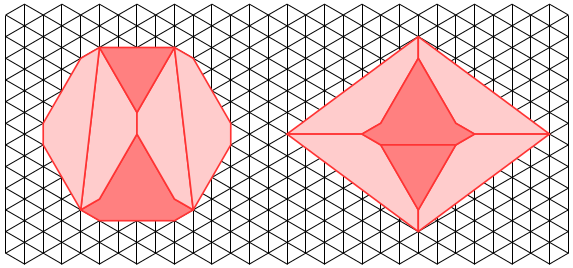
My third and final example involves irregular dodecagons, but this time on a square grid. And while I found the previous two dissections several years ago, I found this example just last week! What inspired me was one of my favorite dissections — from an irregular dodecagon to a square — also found many years ago.
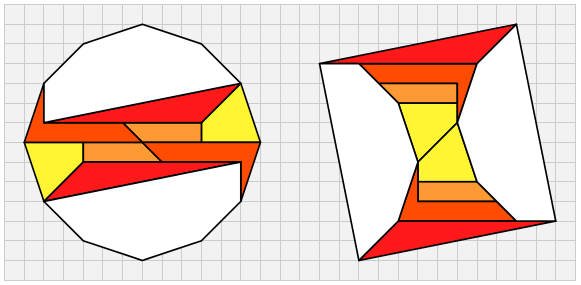
In the spirit of the first two examples, I asked myself if this dissection could be one of an infinite family. The difficulty here was that there were three parameters determining an irregular dodecagon, as shown below.

We do need so that the dodecagon is convex and actually has 12 sides; if
four pairs of sides are in perfect alignment and the figure becomes an octagon.
There is an additional constraint, however, which complicates things a bit. The area of this dodecagon must also be the area of some tilted square with vertices on the grid, as illustrated below. Note that the area of this square is just

It is not a difficult geometry exercise to show that the area of the dodecagon is So in order to create a dissection, we must find a solution to the equation
Again, here is not the place to go into details. But it is possible to find an infinite family of solutions when You get a dissection which looks like this:

I was particularly pleased to have found this eight-piece dissection since most of my attempts until this point had ten pieces or more. And to give you a sense of this family of dissections, here is an example with different parameters within this family.

You can definitely see the resemblance, but it is also clear that the dodecagon and square are not the same shape as those in the previous dissection.
So these are the three families of geometrical dissections I’ll be including in my paper. I hope these examples might inspire you to pick up a pencil and graph paper and try to find some infinite families of your own!
This post has piqued my interest towards geometric dissections.
However, I’m unable to find any practical implications of this concept.
Can anyone help me out on this?
LikeLike
Thanks for the question! For me, these are just intriguing puzzles to solve, which often have fascinating solutions. To be honest, that’s enough for me….
LikeLike